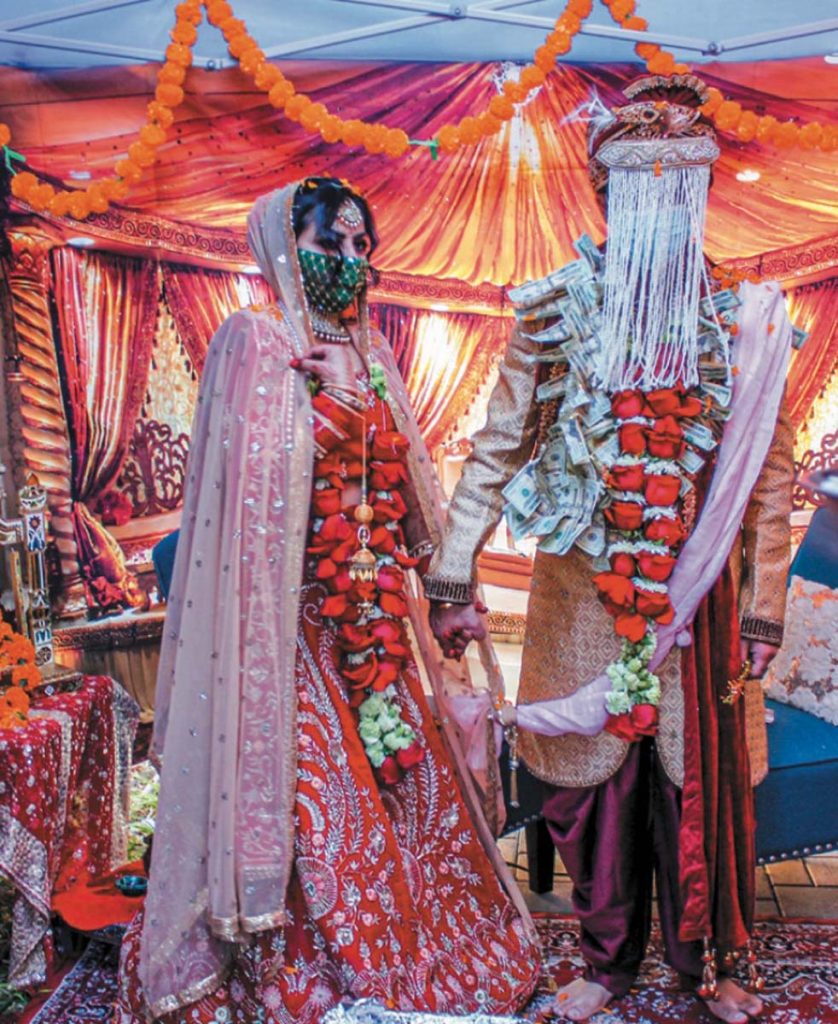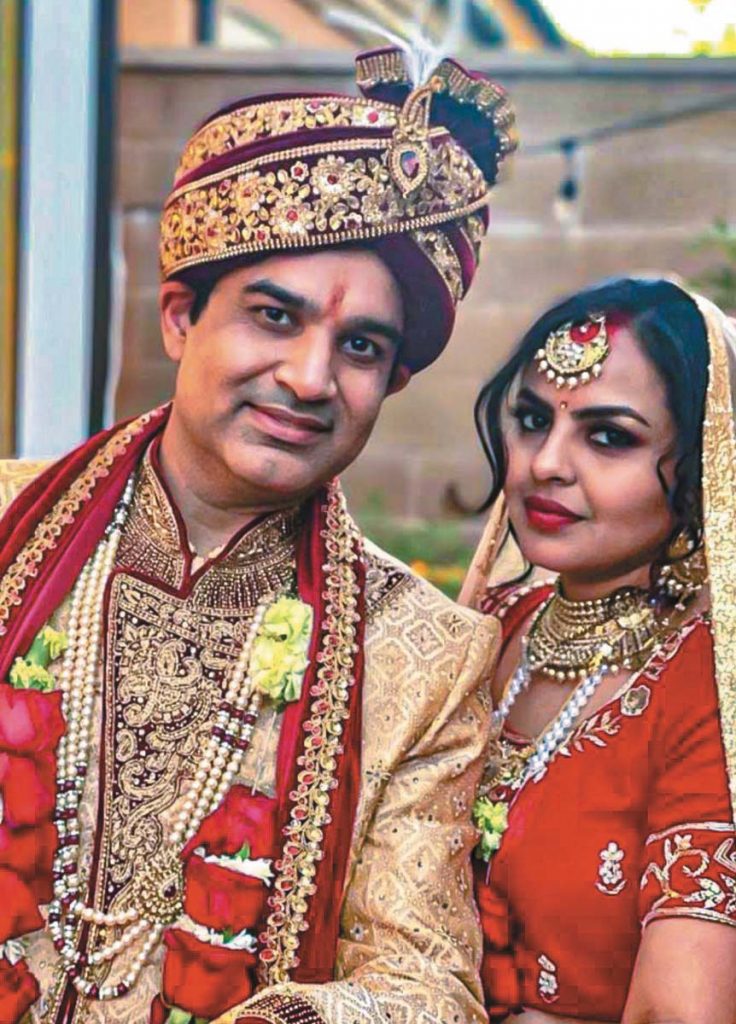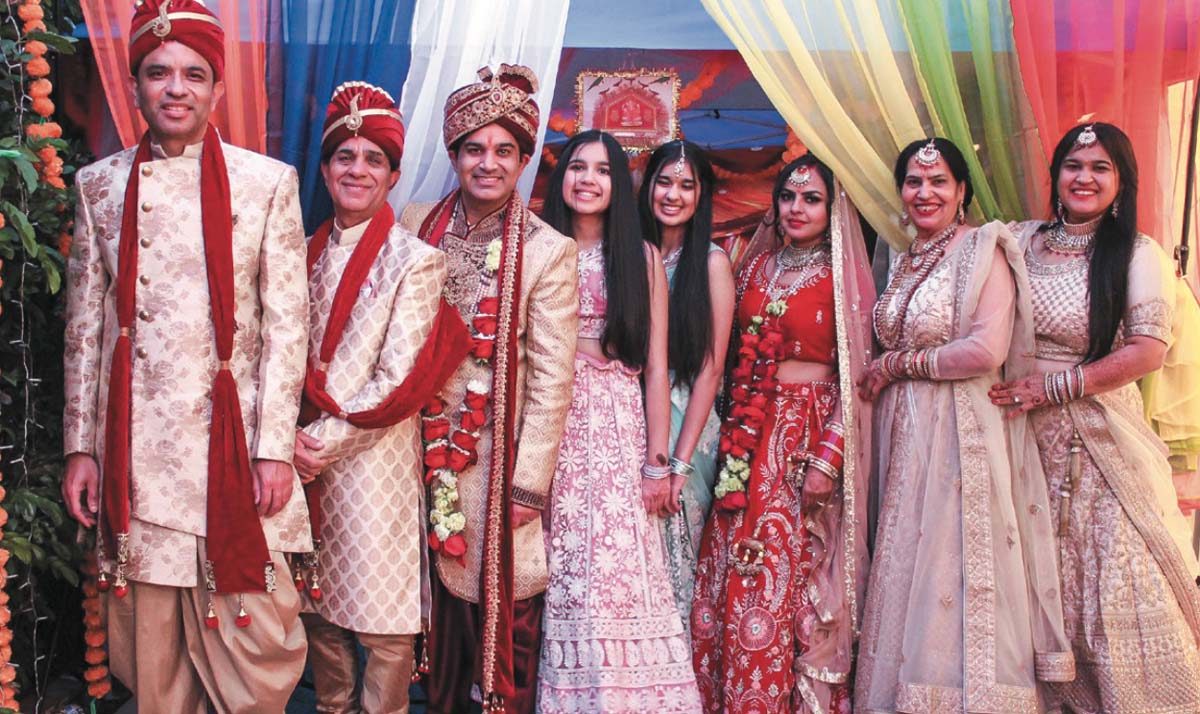Ingenuity, improvisation and inspiration made it a great event
By Shaina Grover, 16, Irvine, California
Hundreds of guests, enough food to last a lifetime, countless celebrations and traditions to follow, elaborate decorations and who knows how many flowers. These are probably just a few of the things that pop into your head when you encounter the words “Indian wedding.” You probably don’t imagine a giant TV with people’s faces on it via zoom.com. But unusual circumstances call for unusual responses.
In America, it is popular to host a Hindu wedding at a grand hall rented out for the weekend. It’s probably not held inside your house. During the Covid-19 pandemic, my Uncle Lokesh got married. Where? In my backyard. You might think it was a small, simple wedding, but that’s where you’d be wrong. My mom, dad, grandparents, aunt-to-be, uncle, sister and I were able to keep the grand feeling of a Hindu wedding with 200 guests, albeit mostly remote, while still taking the necessary safety precautions and inviting no additional in-person guests (except for the priest) for the three-day affair.


If this were a novel or Bollywood movie, the couple would have met on a perilous journey while trying to save the world or on a train in a foreign country. But in 21st-century pandemic reality, they met through a dating website. Once their relationship got serious, the families got involved. Because my aunt’s family was in India and my grandparents were here, most of the communication between the families happened over the phone. My uncle’s side of the family got to meet and get to know my aunt Neha very well (my sister and I started calling her aunt well before the wedding). Because the families were involved from a fairly early stage, I would call this a “semi-arranged marriage.”
We knew in 2019 that the wedding was going to happen soon, so on our trip to India that summer, we bought the majority of our clothes—and. of course, we couldn’t have just bought any random colors, we had to coordinate them. Endless calls to my uncle and grandparents, waking them up at four in the morning, and three extra suitcases later, we finally finished our main clothes shopping. At the time, we had no idea Covid-19 was about to happen, so we even got small return-gifts and bags for the expected guests coming to California—all of which are sitting today in our garage waiting for a party to hand out.
Covid-19 completely caught us off guard. Our initial plans of having a wedding in a grand hotel’s hall with hundreds of guests from across the country went completely down the drain. We had to start our planning from scratch, staying up several nights until three in the morning discussing logistics, making schedules and planning potential menus for each day—because we had to make the food ourselves. People think planning such an event, especially if scaled down, is easy. But after the wedding, my uncle says he now has “so much respect for the wedding planning industry where they do events like this day in and day out on an even larger scale. This experience was definitely a good learning lesson for all of us about thinking outside the box in order to work out the details based on the circumstances.”
Each event or ceremony of the wedding had a coordinated outfit. For example, every-one wore gowns (suits for the men) at the engagement, floral and Banarasi saris at the Ganapati puja, yellow at the haldi ceremony, and green for the mehendi. For the wedding, my aunt had a maroon lehenga (ankle-length skirt) with gold accessories, and my uncle’s sherwani long coat was gold with maroon accessories. My parents and grandparents all wore gold lehengas and sherwanis, and you could even say they were as decked out as the bride. My sister and I maintained the pastel colors theme with matching lehengas in different colors. And of course, masks. Everyone got masks to match their outfits ahead of time so our pictures wouldn’t look too weird.


My aunt-to-be came to stay at our house fourteen days in advance for a self-imposed quarantine after she had been Covid-19 tested, to ensure that everyone was safe. She stayed in my sister’s room, which had a bathroom attached.
We couldn’t have in-person guests, but celebrated with family and friends virtually. My aunt’s parents and relatives in particular weren’t able to come to the US due to Covid-19 restrictions, so for every event, there would be a computer live-streaming from our living room. Personally, I think this setup with video for the relatives could become the new norm, especially with the hassle of getting visas for Indians. During the wedding and engagement, we invited all of my uncle and aunt’s friends to join us through Zoom. The wedding altar included a TV with the faces of everyone who attended—not something you see at a regular wedding. For key events, one computer was set specifically for my aunt and uncle’s family so we could see them at all times. Their friends were able to see what was happening through a separate setup with a phone camera.
The next obstacle was decorations. We obviously couldn’t hire a professional wedding planner, so we had to figure out a way to have grand decorations that were quick and easy to put up and take down. We put up stands with various backdrops, decorated a canopy tent for the altar with curtains, flowers and more backdrops, and put down a fancy red carpet with Rajasthani umbrellas along the edge, all of which gave the whole backyard an elegant look. We also decorated the living room and switched between there and the backyard for different ceremonies.
Another casualty of Covid-19 was a photographer. We did our best with our SLR camera, ring lights and a tripod, and I’d say the pictures turned out really well.


The wedding preliminaries started on Saturday, November 28, with Ganesh puja performed by my grandparents. Usually the couple’s formal engagement would have taken place weeks earlier, but that was also a casualty of Covid-19. Instead, we did a short version that evening with exchange of rings, gift of presents from the groom’s family to the bride and speeches by family and friends, both in person and by Zoom. The traditional haldi purification ceremony for both bride and groom was held Sunday afternoon, and in the evening all the girls had mehendi done. Normally, you hire a professional to create the hand designs with henna dye, but we didn’t want to have anyone in our house or touching us. Instead, we bought stencils online that only required us to fill in the designs with henna. Personally, I think it’s cheating, but I guess we couldn’t have done much else.
That evening, even though we didn’t have guests to dance and sing with, the eight of us did pretty well. Everyone had individual or small group performances that they had prepared beforehand, including my sister and I, followed by everyone dancing to the music. The beauty of the wedding taking place inside our house was that once everyone got tired, we just changed into our pajamas and went back to dancing in the living room.
The wedding, starting late Monday morning, was the only time someone not a part of the family entered our house. The priest arrived and did the basic pre-wedding pujas with my aunt and uncle in the living room, including a prayer for peace in the house, the sehra bandi ceremony where the groom’s sister (my mom) tied a decorative veil to his turban and put a homemade garland of money on him (which at the end was given to my little sister, the youngest present).
The rest of the ceremonies were completed outside, the same as any other Hindu wedding with exchange of flower garlands, taking of vows, going around the havana fire seven times, putting on the mangal sutra, etc. During this entire time, we all wore masks, including the priest. In addition, my uncle wore the shera, bead mask, during parts of the ceremony when he wasn’t supposed to see the bride. Everyone had a mini bottle of hand sanitizer with them, constantly sanitizing after touching anything.
With all the jewelry, masks were a serious hassle. My aunt’s nose ring kept getting caught in the mask, and to top it all off, the heat, smoke and sweat made sitting still for an hour very uncomfortable.
Once the wedding was officially over, there were two more things to do, the first being the ghar pravesh (the bride’s official welcome into the house) and the second, dinner. We actually did the ghar pravesh twice—once at our house immediately after the wedding, and once at my uncle’s house, which we drove to right after.
Even in this most difficult of times, we were able to pull off this wedding, the first I have attended. It may not have been the most conventional, but it was an extraordinary experience nonetheless. My aunt and uncle told me they were “really glad that with the support of our family we were able to celebrate our big day as per Indian traditions, even though we were all stuck inside the house together. As a family, we all were able to make this event memorable to start a new chapter of our life.”
Born in Minnesota, Shaina Grover, 16, is a junior at Northwood High School in Irvine, California. She has an interest in STEM and enjoys traveling, dancing, reading and playing the violin. grover.shaina514@gmail.com


